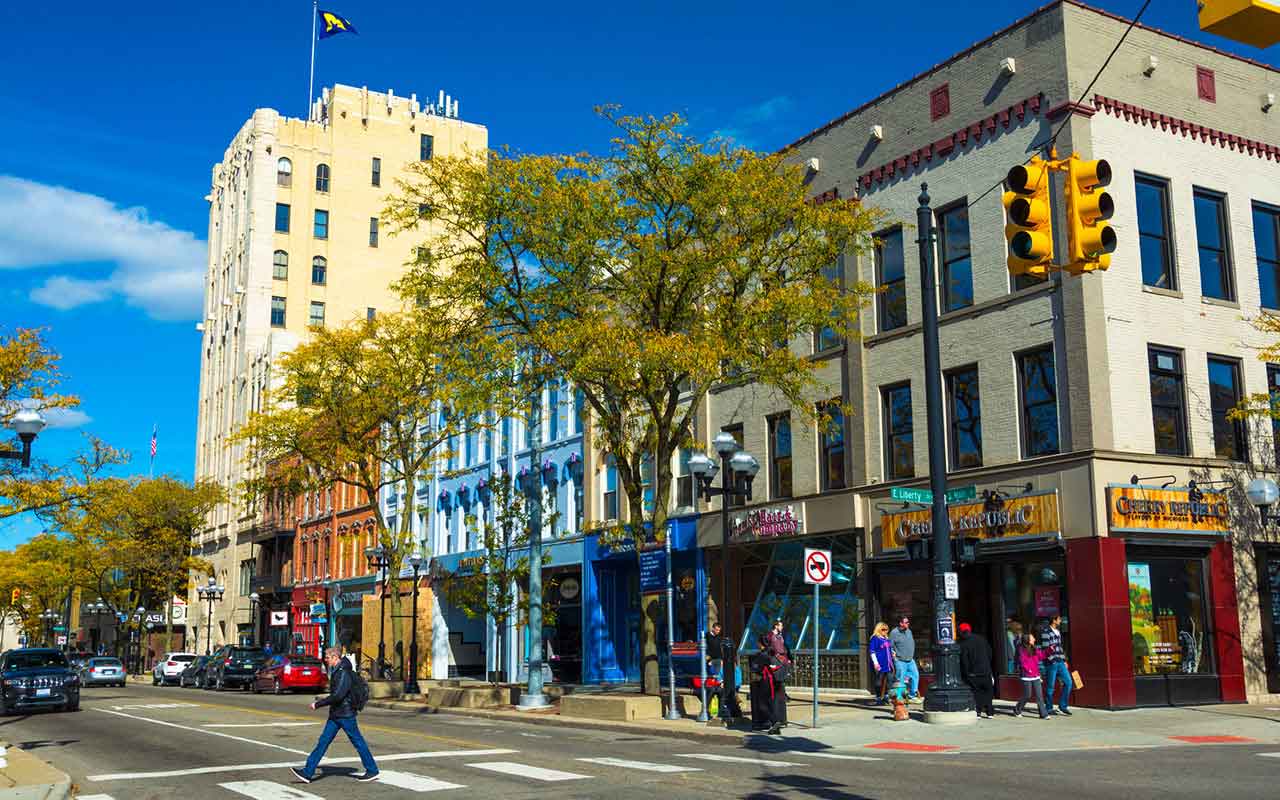10 of the Happiest Places to Retire in the U.S.
A state of happiness cannot be pinpointed on a map.


A state of happiness cannot be pinpointed on a map. But a great deal of residents seem to have found it in these 10 places, according to the Gallup-Sharecare Well-Being Index.
Digital health company Sharecare, working with Gallup, has conducted more than 2.6 million surveys nationwide since 2008 to gauge "Americans' perceptions of their lives and their daily experiences." The Well-Being Index is based specifically on residents' feelings about five elements of well-being: "purpose" (liking what you do and being motivated to achieve goals), "social" (having supportive relationships and love), "financial" (managing your budget to feel secure), "community" (liking where you live) and "physical" (being in good health). The higher the score, on a scale of 0 to 100, the happier residents indicate they are about where and how they are living their lives.
To come up with our original list of the 50 best places to retire in the U.S.—one in each state—we factored in the "community" and "physical" components of the Well-Being Index, where available, as well as living costs, safety, median incomes and poverty rates for retirement-age residents and the availability of recreational and health care facilities. The following 10 retirement destinations rank the highest in terms of the overall well-being of residents. See if you agree, and consider whether any might make a happy place for your own retirement.
Disclaimer
The top 10 cities are listed in reverse order, from 10 to 1, by overall score on the Gallup-Sharecare Well-Being Index. Of our original 50 best places to retire, 35 had well-being scores assigned to them. See "How We Picked the Best Places to Retire" at the end of the list for details on our data sources and methodology.

10. Burlington, Vt.
- Well-being score: 63.0 (U.S.: 61.8)
- City population: 42,453
- Share of population 65+: 10.7%
- Cost of living for retirees: 16.4% above the national average
- Average income for population 65+: n/a
- State's tax rating for retirees: Least Tax Friendly
This small mountain city on the shores of Lake Champlain is a picturesque setting for tree-hugging retirees. Outdoor recreation is plentiful with miles of hiking and biking paths, nearby beaches where you can swim, kayak or paddleboard in the warmer months, and numerous skiing options in the area. An eco-friendly vibe permeates the town, from the businesses bolstering the city's economy, such as household-products maker Seventh Generation, to the local food movement feeding the neighborhood.
But being green isn't easy on your wallet. Taxes and living costs are high. While the median home value is a low $206,000 in the Green Mountain State, compared with the median $229,000 for the U.S., it climbs to $326,500 in Burlington. A private room in a metro area nursing home costs a median $11,498 a month, compared with $8,365 a month for the U.S. At least you can save money on academic pursuits. The University of Vermont will cover tuition costs for state residents age 65 and older who wish to take a class, even if it's for credit.

9. Charleston, S.C.
- Well-being score: 63.1
- City population: 120,903
- Share of population 65+: 12.0%
- Cost of living for retirees: 2.1% above the national average
- Average income for population 65+: $45,574
- State's tax rating for retirees: Tax Friendly
Southern charm, a rich history, city living and nearby beaches combine to make Charleston a uniquely attractive retirement destination. History buffs, in particular, can appreciate the city's Civil War sites, including Fort Sumter, and well-preserved antebellum architecture. The Preservation Society of Charleston is the oldest community-based historic preservation group in the country.
Foodies, too, can find plenty to enjoy along Charleston’s cobblestone streets, especially in the brunch and comfort food areas. And if you need to work off some of those calories, water sports, including surfing, paddle boarding and kayaking, are popular local activities—along with boating and fishing.

8. Provo, Utah
- Well-being score: 63.2
- City population: 116,199
- Share of population 65+: 6.0%
- Cost of living for retirees: 1.7% below the national average
- Average income for population 65+: n/a
- State's tax rating for retirees: Least Tax Friendly
The Beehive State, 10th in our 2018 rankings of the best states for retirement, is a sweet spot for active retirees. And Provo, with mountain peaks within the city limits and Utah Lake on its doorstep, is particularly buzz-worthy. Brigham Young University offers intellectual stimulation to complement the physical activity. Plus, living costs are low while incomes are high, at an average $97,958 a year for residents age 60 and up.
Another feather in its cap: The Milken Institute rates Provo as the best large city for successful aging, noting the area's vibrant economy and safety, as well as the population's healthy lifestyles and high levels of volunteering among older adults. The metro area also has an abundance of health care facilities, about 32 establishments per 1,000 seniors compared with about 19 per 1,000 seniors in the U.S.

7. Richland, Wash.
- Well-being score: 63.6
- City population: 53,991
- Share of population 65+: 15.5%
- Cost of living for retirees: 1.7% below the national average
- Average income for population 65+: $70,059
- State's tax rating for retirees: Tax Friendly
Richland's metro area includes Kennewick, both of which qualify as great retirement destinations. But the smaller of the two, Richland, has an older population with a higher average income (Kennewick's is $57,989) and lower poverty rate (7.6% compared with 8.3% in Kennwick—both lower than the national poverty rate of 9.3% for people age 65 and older).
Whether you're partial to exploring the great outdoors or focusing on wine country, you have plenty of options—you don't even have to choose one over the other. You can enjoy boating and fishing on the Columbia, Yakima and Snake Rivers, and hiking or biking on the 23-mile Sacagawea Trail. There are also more than 200 wineries within a 50-mile radius, offering beautiful views and many wines to sample.

6. Cape Coral, Fla.
- Well-being score: 63.6
- City population: 173,679
- Share of population 65+: 21.9%
- Cost of living for retirees: 2.4% below the national average
- Average income for population 65+: $42,123
- State's tax rating for retirees: Most Tax Friendly
With its desirable climate and favorable tax status, Florida is filled with popular retirement destinations. Many of our favorite retirement spots in the Sunshine State can be found along the Gulf Coast including St. Petersburg, Sarasota and Punta Gorda.
Cape Coral's metro area includes Fort Myers, yet another great place to consider for your retirement. But Cape Coral is unique in its waterway access, offering more than 400 miles of canals for all your boating, fishing and water sports dreams. And land lovers can enjoy the area's beaches, golfing, tennis, parks and other recreational offerings.

5. Durham-Chapel Hill, N.C.
- Well-being score: 63.6
- Metro population: 550,281 (Durham: 257,170)
- Share of population 65+: 13.6% (Durham: 10.8%)
- Cost of living for retirees: 10.5% below the national average
- Average income for population 65+: $63,046 (Durham:$59,567)
- State's tax rating for retirees: Not Tax Friendly
Duke University and the University of North Carolina may be bitter sports rivals, but their hometowns of Durham and Chapel Hill, respectively, team up to form a powerhouse metro area, and a great place to retire. Indeed, the Milken Institute ranks Durham-Chapel Hill as the third best large metro area for successful aging—crediting the area's economic strength, as two-thirds of North Carolina's Research Triangle (the other third being Raleigh), and quality health care. The universities play a big role in those two advantages and also boost up the local cultural and recreational scenes, like in many college towns.
Though not a deal-breaker for every retiree, it’s worth noting that violent crimes are more prevalent in Durham than they are for the nation as a whole. The rate of violent crime is 8.6 per 1,000 residents, according to the Neighborhood Scout, compared with a national median of 4 violent crimes per 1,000 residents. Chapel Hill rates safer, with just 1.8 violent crimes per 1,000 residents. And the real estate values reflect it: The median home value is $382,900 in Chapel Hill and $229,900 in Durham, according to Zillow.

4. Carlsbad, Calif.
- Well-being score: 63.8*
- City population: 113,147
- Share of population 65+: 16.0%
- Cost of living for retirees: 40.6% above the national average
- Average income for population 65+: $70,348
- State's tax rating for retirees: Mixed
Part of the San Diego metro area, Carlsbad offers a small-city feel with easy access to big-city amenities. It has a vibrant cultural community, ocean-side living and sunny climate. You can also find 40 parks, more than 50 miles of hiking trails and a full calendar of artsy offerings, including Foreign Film Fridays in the spring and free concerts in the summer. (Not that there are really seasons in Carlsbad: Throughout the year, average highs fall between 62 and 71 degrees Fahrenheit, and average lows only go down to between 45 and 64 degrees Fahrenheit, according to Weather.com. And rainy days are rare.) Plus, you can choose among a host of retirement communities with ocean views.
Of course, you have to be able to afford it. Like much of California—where living costs are 69% above the national average, making it the second-most expensive state in the country behind only Hawaii—Carlsbad and the whole metro area is a pricey place to live. For example, the median home value in the U.S. is $229,000, according to Zillow; in California, it's $548,600; and in Carlsbad, it's (brace yourself) $860,700. And taxes throughout Cali also weigh heavily on your wallet.
*Data for San Diego-Carlsbad metropolitan statistical area.

3. Portland, Maine
- Well-being score: 63.9
- Share of population 65+: 13.7%
- Cost of living for retirees: 17.1% above the national average
- Average income for population 65+: $44,769
- State's tax rating for retirees: Mixed
The largest city in Maine, Portland offers a lively downtown and plenty of urban-esque amenities amidst the great outdoors of the Pine Tree State. You can enjoy museums, theaters and an array of eclectic dining. The flagship L.L. Bean store in nearby Freeport is a must-see for many visitors, but resident shoppers also flock to Portland’s unique boutiques and outlets.
All the while, you’re never too far from the area's many beaches. That means ample opportunity to lounge on the shore or dive into water-based activities including fishing, kayaking, sailing and even surfing. And of course, hiking and biking trails abound—perfect in the (much) colder months, too, for cross-country skiing and snowshoeing.

2. Ann Arbor, Mich.
- Well-being score: 64.4
- City population: 119,303
- Share of population 65+: 11.3%
- Cost of living for retirees: n/a
- Average income for population 65+: $82,971
- State's tax rating for retirees: Not Tax Friendly
Another college town well suited to retirees, Ann Arbor is home to the University of Michigan with all its educational programs (including the Osher Lifelong Learning Institute), sporting events and cultural affairs. The university also runs the Geriatrics Center & Institute of Gerontology, which focuses on health care issues that come with aging. Along with its research facilities, medical facilities and staff, the Center offers programs and classes to help older adults maximize their good health and independence.
In fact, Ann Arbor's health care facilities are top-notch, helping to earn it a sixth-place ranking among small metro areas for successful aging, according to the Milken Institute. The area's public transportation options are another noted winning attribute for older residents. A downside, however, is affordability. Overall living costs are 27.1% above the national average, according to Sperling's BestPlaces, and the median home value is $378,600, versus just $153,000 for the rest of the state, according to Zillow.

1. Charlottesville, Va.
- Well-being score: 65.0
- City population: 46,487
- Share of population 65+: 10.4%
- Cost of living for retirees: 0.2% below the national average
- Average income for population 65+: n/a
- State's tax rating for retirees: Tax Friendly
Renaissance man Thomas Jefferson laid the foundation for the well-rounded city his hometown has become. From his University of Virginia's hollering Hoos to the artists on the downtown promenade, the Charlottesville community is an unexpected blend of Southern charm and liberal edge, a nice choice for a range of retiree personalities. And beyond the college campus and city center, you can find plenty of options for outdoor recreation in the foothills of the Blue Ridge Mountains, including more than 100 miles of of the Appalachian Trail in nearby Shenandoah National Park.
In August 2017, Charlottesville captured national attention when a gathering of white nationalists to protest the removal of a monument to Robert E. Lee turned into a violent rally, injuring dozens of counter-protesters and killing one, Heather Heyer. In general though, the city's violent crime rate is a low 175.4 reported incidents per 100,000 residents, compared with a 297.8 rate for all U.S. cities of similar size, according to the FBI. Charlottesville also ranks fifth for overall well-being, out of all 187 metro areas included in the Gallup-Sharecare Well-Being Index, with above-average scores in all categories, including physical health and resident satisfaction.

How We Picked the 50 Best Places to Retire
To pinpoint one great retirement destination in each state, we weighed a number of factors:
- Cost of living for retirees for major metropolitan and micropolitan statistical areas, with data provided by the Council for Community and Economic Research, includes overall costs, housing, food and groceries, transportation, utilities, health care and miscellaneous expenses.
- Household incomes, poverty rates and number of health care facilities are from the U.S. Census Bureau.
- Community well-being and physical well-being scores are provided by digital health company Sharecare, in collaboration with Gallup. These are two of the five elements of well-being that make up the overall Gallup-Sharecare Well-Being Index. (The other three elements are purpose, social and financial well-being.) The index is calculated on a scale of 0 to 100 and based on more than 2.5 million nationally representative surveys. Community well-being is defined as "liking where you live, feeling safe and having pride in your community." Physical well-being is "having good health and enough energy to get things done daily." We display the community score for each place we chose.
- Population data, including the percentage of the population that is age 65 and older, is also provided by the Census Bureau. The figures are highlighted in these rankings for the benefit of readers, but were not factors in our methodology for ranking the best places to retire.
- Taxes on retirees, based on Kiplinger's Retiree Tax Map, which divides states into five categories: Most Tax Friendly, Tax Friendly, Mixed, Not Tax Friendly and Least Tax Friendly. This information is provided for the benefit of readers but was not factored into our selections within each state.
Get Kiplinger Today newsletter — free
Profit and prosper with the best of Kiplinger's advice on investing, taxes, retirement, personal finance and much more. Delivered daily. Enter your email in the box and click Sign Me Up.

Rapacon joined Kiplinger in October 2007 as a reporter with Kiplinger's Personal Finance magazine and became an online editor for Kiplinger.com in June 2010. She previously served as editor of the "Starting Out" column, focusing on personal finance advice for people in their twenties and thirties.
Before joining Kiplinger, Rapacon worked as a senior research associate at b2b publishing house Judy Diamond Associates. She holds a B.A. degree in English from the George Washington University.
-
 Doing This With Your 401(k) Could Cost You $18,000
Doing This With Your 401(k) Could Cost You $18,000Your old 401(k) accounts may be slowly bleeding money — because the power of compounding can work against you, too.
By Christy Bieber
-
 Five DIY Security Upgrades That Can Lower Your Home Insurance Premium
Five DIY Security Upgrades That Can Lower Your Home Insurance PremiumProtect your home and your wallet with these easy, affordable upgrades that may qualify you for insurance discounts.
By Paige Cerulli
-
 What to Do With Your Tax Refund: 6 Ways to Bring Growth
What to Do With Your Tax Refund: 6 Ways to Bring GrowthUse your 2024 tax refund to boost short-term or long-term financial goals by putting it in one of these six places.
By Rachael Green
-
 What Does Medicare Not Cover? Eight Things You Should Know
What Does Medicare Not Cover? Eight Things You Should KnowHealthy Living on a Budget Medicare Part A and Part B leave gaps in your healthcare coverage. But Medicare Advantage has problems, too.
By Donna LeValley
-
 12 Great Places to Retire in the Midwest
12 Great Places to Retire in the MidwestPlaces to live Here are our retirement picks in the 12 midwestern states.
By Stacy Rapacon
-
 10 Cheapest Small Towns to Live In
10 Cheapest Small Towns to Live InThe cheapest small towns might not be for everyone, but their charms can make them the best places to live for plenty of folks.
By Dan Burrows
-
 15 Reasons You'll Regret an RV in Retirement
15 Reasons You'll Regret an RV in RetirementMaking Your Money Last Here's why you might regret an RV in retirement. RV-savvy retirees talk about the downsides of spending retirement in a motorhome, travel trailer, fifth wheel or other recreational vehicle.
By Bob Niedt
-
 The Cheapest Places To Retire in the US
The Cheapest Places To Retire in the USWhen you're trying to balance a fixed income with an enjoyable retirement, cost of living is a crucial factor to consider.
By Stacy Rapacon
-
 The Six Best Places to Retire in New England
The Six Best Places to Retire in New Englandplaces to live Thinking about a move to New England for retirement? Here are the best places to land for quality of life, affordability and other criteria.
By Stacy Rapacon
-
 13 Smart Estate Planning Moves
13 Smart Estate Planning Movesretirement Follow this estate planning checklist for you (and your heirs) to hold on to more of your hard-earned money.
By Janet Kidd Stewart
